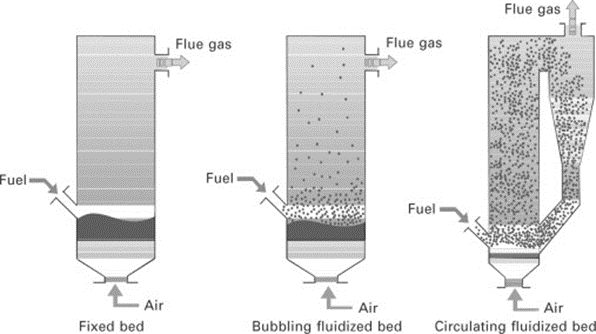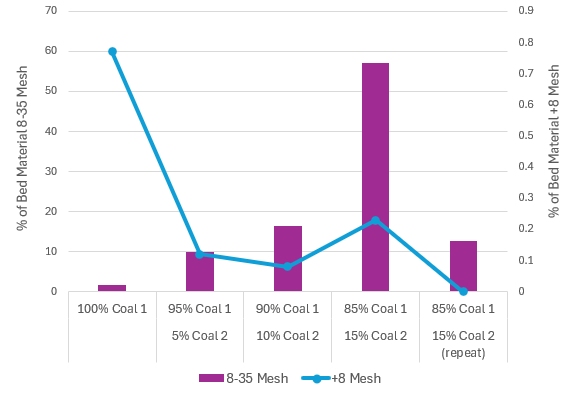Fluidized-Bed Combustion: Case Study Evaluating Coal Blend Performance
Introduction
Microbeam Technologies, Inc (MTI) has developed a proprietary experimental test procedure and a set of performance indices to assess the impact of ash-related properties on agglomeration and ash behavior in a fluidized-bed combustion system. These tools offer a predictive capability for assessing the effects of blending different coal feedstocks on ash behavior, helping to optimize system performance.
Background
Fluidized-bed combustion (FBC) systems operate by burning solid fuels in a bed of ash, inert material, or a sorbent for sulfur capture where air is used to fluidize the bed particles and provide oxygen for combustion. This process suspends the fuel and bed material particles, allowing the bed to behave like a fluid (Figure 1). FBC systems are known for their high fuel flexibility, efficiently burning a wide range of fuels such as coal, biomass, petroleum coke, and various waste materials.
Several factors can influence performance of FBC systems, including:
Key concerns in PC-fired systems related to fuel properties include:
Erosion in areas with high solids circulation
Bed agglomeration and its impact on ash cooling equipment
Fouling of reactor walls, cyclones, and convective pass surfaces at both high and low temperatures
Fine ash behavior in particulate control systems
Among these, bed agglomeration poses one of the greatest challenges. It occurs when liquid or bonding phases form on the surface of the bed material. Fuels like lignite and biomass, which contain high levels of alkali elements (such as sodium and potassium), can react to form compounds that promote agglomeration. This phenomenon can impair bed fluidization and, if left unchecked, may lead to complete bed defluidization.
Figure 1. Comparison of fixed bed and fluidized-bed combustion systems.
Case Study: Evaluating Coal Blend Performance in a Fluidized-Bed Combustion System
MTI collaborated with the University of North Dakota to determine how blending of coal feedstocks affects performance in a bubbling fluidized bed combustion system. A bench-scale fluidized bed reactor at Microbeam was used to assess the agglomeration behavior of four coal blends. Figures 2 and 3 show the agglomerates formed during combustion and the physical build up on the side wall inside the fluid bed.
Figure 2. (Left) Agglomerates formed during combustion of 100% coal #1; Figure 3. (Right) Side wall build up observed inside the fluid bed.
Key findings from experimental testing are summarized below:
Strength Index: Higher proportions of Coal #2 in the blend were associated with a lower Strength Index, indicating reduced deposit strength.
Large agglomerates were observed after combusting Coal #1
Agglomerate size decreased for blends containing higher amounts of Coal #2 (Figure 4)
Significant side wall build up was observed for the higher blends
Agglomerates consisted mainly of Si and Ca with lesser amounts of S, Fe, Na, Al, and Mg
Figure 4. Size of agglomerates recovered from fluid bed.
Performance predictions were calculated for the four blends to compare against experimental results (Table 1). Major findings are provided below:
Decreases in sulfation index (indicates bonding due to sulfate liquid phases) and cohesivity predict that as the amount of Coal #2 in the blend increases, agglomeration would decrease
Strength index (predicts sintering due to abundance and viscosity of liquid phase) values of 0.32-0.34 suggest that the blends containing Coal #2 are likely to form deposits of low to moderate strength
Both experimental data and modeling results indicated a reduction in agglomeration with higher Coal #2 blends, likely due to the lower sodium content as more Coal #2 was introduced. The sulfation index, used to predict deposit strength, also aligned with the increased side-wall buildup seen in the higher coal blends.
Table 1. Summary of performance predictions associated with fluidized bed performance.
Summary
MTI’s bench-scale bubbling FBC testing protocol, combined with proprietary performance indices, offers a powerful tool for predicting coal blend behavior in FBC systems. By leveraging these insights, clients can optimize their fuel blends to minimize bed agglomeration, enhancing system efficiency and plant performance. MTI has conducted over 300 test runs using the fluid bed agglomeration and ash formation tests on biomass, plastics, municipal solid waste (MSW) materials, coal, petroleum coke, oil sands, and blends (coal/biomass, coal/petcoke, plastic/MSW).





